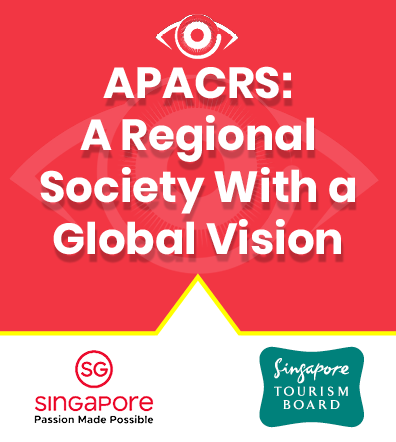Eyeworld Weekly Update |
Volume 20, Number 38 |
2 October 2015 |
- In memoriam: Jan G.F. Worst
- Dextenza filed for post-surgical ocular pain
- ReVision submits final PMA module for Raindrop inlay
- NDA for Medidur planned with 6-month data
- Tear samples may help diagnose keratoconus
In memoriam: Jan G.F. Worst
Longtime ASCRS member Jan G.F. Worst passed away on September 25 in his hometown of Groningen, the Netherlands.
With the Jan Worst Research Group, he created and developed simple tools for cataract surgery that greatly helped to relieve cataract-induced blindness in developing countries, according to Michael C. Knorz, MD, executive director, International Intraocular Implant Club (IIIC). "Not only did he provide free surgical services in small rural villages throughout India, Nepal, and Pakistan himself, he never ceased to encourage his colleagues to offer their services to those less fortunate," Dr. Knorz said.
In 1976, Dr. Worst was the recipient of the ASCRS Binkhorst Medal and Lecture, and in 1999, he was the first recipient of the IIIC G.F. Jan Worst Medal and Lectureship.
Dextenza filed for post-surgical ocular pain
Dextenza (sustained release dexamethasone 0.4 mg intracanalicular depot) has been filed for U.S. regulatory approval for the treatment of ocular pain following ophthalmic surgery, developer Ocular Therapeutix (Bedford, Mass.) said in a news release. The data included in the NDA submission are from a phase 2 clinical trial and two phase 3 clinical trials. A third phase 3 study is expected to start this month.
Dextenza is placed through the punctum into the canaliculus and is designed to deliver dexamethasone to the ocular surface for 4 weeks. Following treatment, Dextenza resorbs and exits the nasolacrimal system without need for removal. The drug is also in phase 2 studies for the treatment of inflammatory dry eye and a phase 3 study for allergic conjunctivitis. Topline data from both those additional studies are expected in the fourth quarter.
ReVision submits final PMA module for Raindrop inlay
ReVision Optics (Lake Forest, Calif.) has submitted the fourth and final module of the company's Premarket Approval (PMA) application for the Raindrop Near Vision Inlay, ReVision said in a news release. The fourth module includes clinical data from more than 300 subjects who have been followed for at least 24 months post-procedure.
Raindrop is a microscopic hydrogel inlay designed to correct presbyopia. The company expects an approval in mid-2016.
NDA for Medidur planned with 6-month data
A New Drug Application (NDA) for Medidur for posterior uveitis based on 6-month efficacy data for two phase 3 trials has been deemed acceptable for review by the Food and Drug Administration, developer pSivida Corp (Watertown, Mass.) said in a news release. Topline results from the first of the phase 3 studies will likely be reported in December, pSivida said. Enrollment in the second phase 3 trial continues and is expected to be completed during the first half of 2016, with an NDA anticipated in the first half of 2017.
Medidur is an injectable micro-insert designed to treat posterior uveitis that provides sustained release of fluocinolone acetonide for 3 years. pSivida's two phase 3 trials for Medidur are double-masked studies comparing injections of Medidur to sham injections on a two-to-one basis. The primary endpoint of both trials is recurrence of uveitis within 6 months. The first trial is fully enrolled with 129 patients in 16 centers in the U.S. and 17 centers outside the U.S.
Medidur comprises the same micro-insert (same design, same polymers, same drug, same dose) as Iluvien for diabetic macular edema. Iluvien has been approved in the U.S. and 17 EU countries and is sold in the U.S., the U.K., Germany, and Portugal.
Tear samples may help diagnose keratoconus
A group of researchers in Bangalore have found tear samples may help predict and prevent keratoconus, according to Narayana Nethralaya Eye Hospital. In 2007, the hospital saw fewer than 50 keratoconus cases, but that increased to between 8-10 cases daily by 2015. In just 1% of the patients, the disorder is genetic, and the rest was due to allergies.
Rohit Shetty, PhD, found visual system homeobox 1 (VSX1) as the gene responsible, after having tested more than 500 tear samples. Of interest, Dr. Shetty also found that keratoconus is not an inflammatory disorder. Dr. Shetty and Rudy Nuijts, MD, Maastricht University, the Netherlands, collaborated on the research.
RESEARCH BRIEFS
- Lifitegrast met the co-primary symptom endpoint (eye dryness) but not the co-primary sign endpoint (inferior corneal staining) in a phase 3 study, J. Tauber and colleagues found. Lifitegrast is an integrin antagonist that decreases T-cell-mediated inflammation associated with dry eye disease; it is being evaluated for the treatment of dry eye disease in the OPUS-2 study. The 12-week, multicenter, randomized, prospective, double-masked, placebo-controlled clinical trial enrolled 718 subjects (n=358 in the lifitegrast group). Lifitegrast-treated subjects experienced greater improvement in eye dryness than placebo-treated subjects (treatment effect, 12.61; 95% confidence interval [CI], 8.51-16.70; P<0.0001). There was no between-group difference in inferior corneal staining. There was nominally significant improvement of secondary symptom endpoints among lifitegrast-treated subjects: ocular discomfort (nominal, P=0.0005) and eye discomfort (nominal, P<0.0001). There were no between-group differences on secondary signs: total corneal staining and nasal lissamine staining. The study is published in Ophthalmology.
- A 10-year single-center study in the United Kingdom has confirmed the long-term safety and efficacy of phaco-deep sclerectomy (DS) as a primary glaucoma procedure. K. Mercieca and colleagues evaluated 296 eyes (282 patients) that had undergone the combined procedure. Intraocular pressure (IOP) success criteria were: (A) IOP <19mm Hg and/or 20% decrease from baseline and (B) IOP <16 mm Hg and/or 30% drop from baseline. Mean follow-up was 63.5±35.3 months. MMC was applied in 145 eyes (49%). Kaplan-Meier success rates in all eyes for criteria A were 89.1% and 80% with glaucoma medications (qualified success) and 81.2% and 68.3% without medications (unqualified success) at 2 and 5 years, respectively. Qualified success for criteria B was 72.4 and 61.4% and unqualified rates were 67.2 and 55.2% for the same time periods. Repeated-measures ANOVA showed significantly lower IOP in the phaco-DS with MMC group up to 3 years postoperatively (P=0.002). Cox's proportional hazards for criteria B, however, showed no significant effect of MMC application in the long term (P=0.2). Increasing age and laser goniopuncture were positively associated with success, whereas the absence of spacer devices was negatively associated. At last follow-up, 20% of eyes were on glaucoma medications. The study is published ahead of print in Eye.
- Intermediate, posterior and panuveitis have a similarly favorable prognosis with both systemic and fluocinolone acetonide implant treatment, according to results from the Multicenter Uveitis Steroid Treatment (MUST) Trial. J.H. Kempen and colleagues evaluated the 2-year outcomes in 479 intermediate, posterior, and panuveitic eyes in this cohort study designed to evaluate potential predictive factors for baseline best corrected visual acuity (BCVA) and the 2-year change in BCVA. Baseline factors significantly associated with reduced BCVA included: age ≥50 vs. <50 years; posterior vs. intermediate uveitis; uveitis duration >10 vs. <6 years; anterior chamber (AC) flare >grade 0; cataract; macular thickening; and exudative retinal detachment. Over 2 years, eyes better than 20/50 and 20/50 or worse at baseline improved, on average, by 1 letter (p=0.52) and 10 letters (p<0.001), respectively. Both treatment groups and all sites of uveitis improved similarly. Factors associated with improved BCVA included resolution of active AC cells, of macular thickening, and cataract surgery in an initially cataractous eye. Factors associated with worsening BCVA included longer duration of uveitis (6-10 or >10 vs. <6 years), incident AC flare, cataract at both baseline and follow-up, pseudophakia at baseline, persistence or incidence of vitreous haze, and incidence of macular thickening. The study is published online ahead of print in theAmerican Journal of Ophthalmology.
NEW PRODUCT BRIEFS
- ManagementPlus (Salt Lake City) has introduced ManagementPLUS Cloud and Revenue Cycle Management. ManagementPLUS Cloud allows practices to back up and store vital health records and applications to remote and secure servers, while Revenue Cycle Management "ensures claims get timely attention to detect and avoid delays in payments and write-offs," the company said.
 Licensed Publications |
Licensed through ASCRS American Society of Cataract and Refractive Surgery, 4000 Legato Road, Suite 700, Fairfax, VA 22033-4003, USA.
All rights reserved. The ideas and opinions expressed in EyeWorld Asia-Pacific Weekly News do not necessarily reflect those of the ASCRS�ASOA or APACRS. Mention of products or services does not constitute an endorsement by the ASCRS�ASOA or APACRS. Copyright 2008, EyeWorld News Service, a division of ASCRS Media. |



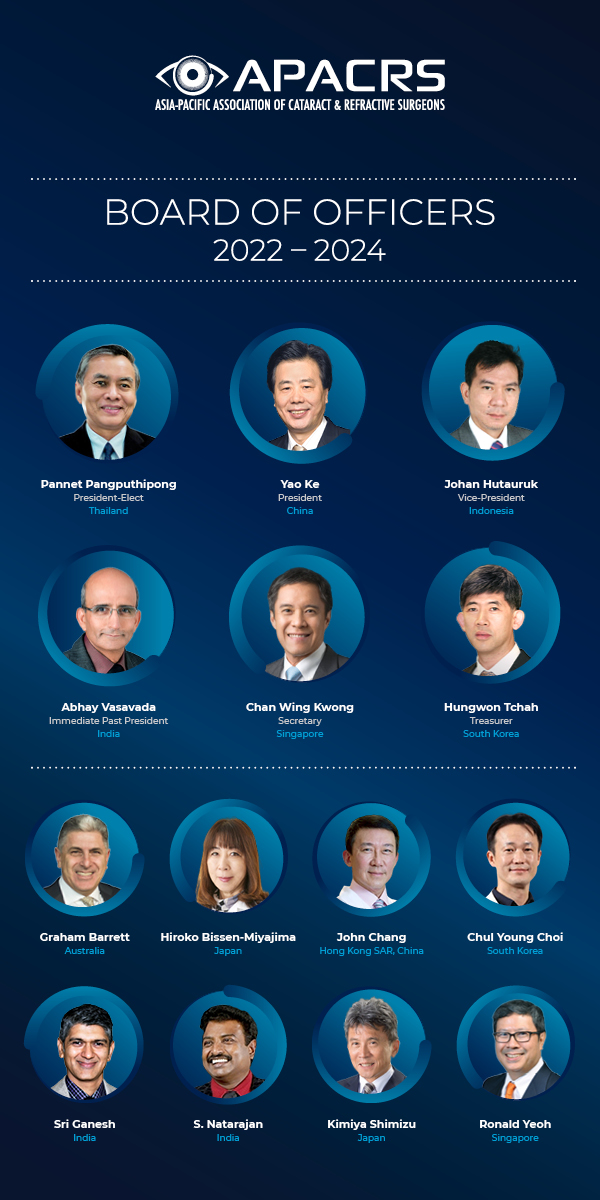
 EyeSustain Update
EyeSustain Update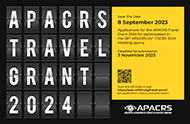 2024 APACRS TRAVEL GRANT
2024 APACRS TRAVEL GRANT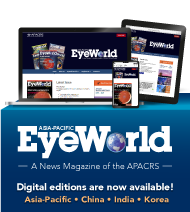 Digital EyeWorld
Digital EyeWorld VOL. 39 (2023), ISSUE 3
VOL. 39 (2023), ISSUE 3  Membership Information
Membership Information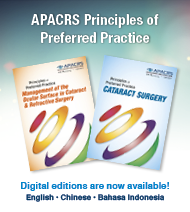 APACRS Principles of Preferred Practice
APACRS Principles of Preferred Practice